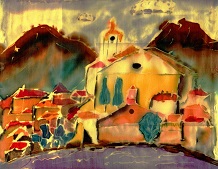Vulkan Misti (or
Mount Misti) is one of
the most iconic and prominent volcanoes in
Peru, towering over the
city of Arequipa. It’s
a stunning sight, often associated with the city’s landscape, and it
holds both natural beauty and a touch of mystery. Here’s everything you
need to know about it:
Overview of Mount Misti:
-
Height:
Misti stands at
about 5,822 meters (19,101
feet) above sea level, making it one of the tallest
volcanoes in southern Peru.
-
Location: It is
located about 17 kilometers
(10.5 miles) northwest of Arequipa, so it's easily visible
from the city. The volcano is an essential part of the Arequipa
skyline.
-
Type: Misti is an
active stratovolcano,
which means it has a conical shape and is made up of layers of
hardened lava and volcanic ash. It has had several eruptions in
history, with the most recent being in the
18th century (about
1780).
Climbing Mount Misti:
Misti is a popular destination for
adventurous travelers and climbers. Here's what you need to know if
you're considering an ascent:
-
Trekking and Hiking:
-
Difficulty:
The hike is considered
moderately difficult to challenging, primarily due to
the high altitude and steep terrain. The altitude can cause
discomfort or altitude sickness, so it’s important to be
well-prepared and acclimatized.
-
Duration:
Most expeditions to the summit of Misti take
2-3 days,
depending on the route and your pace. The climb itself typically
takes around 6-8 hours
to reach the summit from the base camp, but the journey often
includes an overnight stay at a camp along the way.
-
Route: There
are several different routes to the summit, including the
Base Camp route
and the Colca Valley
route, each offering unique views and varying levels of
difficulty.
-
What to Expect:
-
Terrain: The
climb involves a mix of rocky paths, volcanic ash, and scree. In
the higher elevations, the air is thin and the temperature can
drop significantly, even in the summer.
-
Scenic Views:
From the summit, you’ll be treated to incredible panoramic views
of the Arequipa city
below, the surrounding
Chachani and
Pichu Pichu volcanoes, and the vast desert landscape.
You can even see the
Colca Canyon in the distance on clear days.
-
Crater: The
summit has a small
crater (though it’s not actively erupting), and you
might catch a glimpse of some
steam rising
from fumaroles (small volcanic vents).
-
Best Time to Climb:
- The best time to climb
Misti is during the
dry season, which typically runs from
May to September.
This time offers clearer skies and more stable weather. However,
you should always be prepared for sudden changes in weather,
especially at high altitudes.
-
Guided Tours:
- Most climbers choose to go
with a local guide.
Guided tours often include transportation to and from Arequipa,
a trek to the base camp, necessary equipment, and the expertise
of an experienced guide. It’s important to hire a certified
guide for safety and navigation reasons.
Significance of Mount Misti:
-
Symbol of Arequipa:
Misti is considered a symbol of Arequipa and is often referred to as
the “Guardian of Arequipa”
because it watches over the city. It’s often depicted in local art
and is a central part of the city's identity.
-
Cultural Importance:
The mountain has been an important feature for the
Inca and
pre-Inca
cultures, who considered volcanoes sacred. Some theories suggest
that Mount Misti, along with nearby
Chachani, may
have been part of ancient religious rituals and offerings.
-
Geological Importance:
The study of Misti helps scientists understand the processes of
active volcanoes and their potential hazards. While it's been
dormant for centuries, it remains an active volcano, and its
eruptions in the past have been significant.
Mount Misti's Volcano Tours
and Activities:
-
Hot Springs:
After a challenging trek, you can relax in nearby
hot springs, such
as those found in Chivay
(near Colca Canyon), which are perfect for unwinding.
-
Adventure Sports:
If you're not into climbing but want to experience Misti in a
different way, you could try
mountain biking
or ATV tours in
the surrounding area.
Safety Considerations:
-
Altitude Sickness:
Due to the high altitude, it's critical to acclimatize before
attempting the climb. Visitors should spend a few days in
Arequipa before
attempting to hike Misti to avoid altitude sickness.
-
Weather: Always
check the weather forecast, as conditions can change rapidly, and be
prepared for extreme cold at high altitudes.
-
Proper Gear: Wear
appropriate hiking boots, warm layers, sunscreen, and bring enough
water and food for the trek.
Getting to Mount Misti:
- Most visitors take a
guided tour from
Arequipa, which
includes transportation to the starting point of the hike. These
tours typically provide necessary gear and guides who are
experienced with the route.
- You can also arrange for a
private guide or
trekking company
in Arequipa, especially if you prefer a more tailored experience.
Why Visit Mount Misti?
- Mount Misti is a
bucket-list destination
for trekkers and climbers due to its challenging nature and stunning
views. It offers a sense of adventure and accomplishment, along with
breathtaking views that few other places in Peru can provide.
- Even if you don’t plan to
climb it, the view of Misti from Arequipa is a magnificent sight and
part of the city’s charm.
 Safaris
Bergsteigen
Wandern
Inselwandern Weltweit
Safaris
Bergsteigen
Wandern
Inselwandern Weltweit
 Europa
Inselwandern
Europa
Inselwandern
 Städtewandern
Städtewandern
 Paintings
Paintings Dirk Rauschenbach
Dirk Rauschenbach
 Safaris
Bergsteigen
Wandern
Inselwandern Weltweit
Safaris
Bergsteigen
Wandern
Inselwandern Weltweit
 Europa
Inselwandern
Europa
Inselwandern
 Städtewandern
Städtewandern
 Paintings
Paintings Dirk Rauschenbach
Dirk Rauschenbach
![]() 26.07.25 Copyright Dirk
Rauschenbach Koelnerstrasse 293 51702 Bergneustadt
Datenschutzerklaerung 02261 9788972 Mail ccooly(
at) web.de
26.07.25 Copyright Dirk
Rauschenbach Koelnerstrasse 293 51702 Bergneustadt
Datenschutzerklaerung 02261 9788972 Mail ccooly(
at) web.de